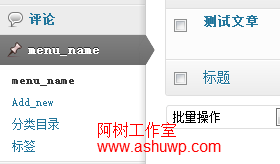前面刚建了给WordPress创建新的文章类型函数:register_post_type()该函数还有个taxonomies参数,用来给自定义文章类型添加分类法制止,给wordpress添加默认的分类和标签支持方法很简单,只需要在创建文章类型的时候设置taxonomies参数如下:
'taxonomies'=> array('category','post_tag'), <?php register_taxonomy($taxonomy, $object_type, $args); //$taxonomy 字符串型,必需,分类法的名称,用英文哦 //$object_type 数组或字符串,必需,分类法所对应的文章类型 //$args--可选,配置参数 ?> <?php add_action('init', 'my_custom_init'); function my_custom_init() { $labels = array( 'name' => '书本name', 'singular_name' => '书本singularname', 'add_new' => 'Add_new', 'add_new_item' => 'add_new_item', 'edit_item' => 'edit_item', 'new_item' => 'new_item', 'view_item' => 'view_item', 'search_items' => 'search_items', 'not_found' => 'not_found', 'not_found_in_trash' => 'not_found_in_trash', 'parent_item_colon' => '', 'menu_name' => 'menu_name' ); $args = array( 'labels' => $labels, 'description'=> '嘿,这是一个自定义的文章类型', 'public' => true, 'publicly_queryable' => true, 'show_ui' => true, 'show_in_menu' => true, 'query_var' => true, 'rewrite' => true, 'capability_type' => 'post', 'has_archive' => true, 'hierarchical' => false, 'menu_position' => null, 'taxonomies'=> array('category','post_tag'), 'supports' => array('title','editor','author','thumbnail','excerpt','comments') ); register_post_type('book',$args); $labels = array( 'name' => '国籍', 'singular_name' => 'country', 'search_items' => '搜索' , 'popular_items' => '热门' , 'all_items' => '所有' , 'parent_item' => null, 'parent_item_colon' => null, 'edit_item' => '编辑' , 'update_item' => '更新' , 'add_new_item' => '添加' , 'new_item_name' => '国籍名称', 'separate_items_with_commas' => '按逗号分开' , 'add_or_remove_items' => '添加或删除', 'choose_from_most_used' => '从经常使用的类型中选择', 'menu_name' => '国籍分类', ); register_taxonomy( 'country', array('book'), array( 'hierarchical' => true, 'labels' => $labels, 'show_ui' => true, 'query_var' => true, 'rewrite' => array( 'slug' => 'country' ), ) ); } ?>
效果如图:

然后这在实际中的用法很少,一般情况下我们使用新的分类法,比如我们要做一个企业站,给产品做了一个新的文章类型product。我们要给产品归类,可以按类别分,比如电脑、手机。还可以按产地分,比如:国产山寨、水货,还可以按价格区间分,比如:1000元以下、1000到3000,等等,我们就需要同时有3个分类法:类别、产地、价格区间。
在本部分教程的第一篇中我们也提到了,在wp-includes/post.PHP文件中wordpress使用register_taxonomy函数创建了分类-category和标签-post_tag两个分类法。
下面是register_taxonomy函数的参数好用法:
'taxonomies'=> array('category','post_tag'), <?php register_taxonomy($taxonomy, $object_type, $args); //$taxonomy 字符串型,必需,分类法的名称,用英文哦 //$object_type 数组或字符串,必需,分类法所对应的文章类型 //$args--可选,配置参数 ?> <?php add_action('init', 'my_custom_init'); function my_custom_init() { $labels = array( 'name' => '书本name', 'singular_name' => '书本singularname', 'add_new' => 'Add_new', 'add_new_item' => 'add_new_item', 'edit_item' => 'edit_item', 'new_item' => 'new_item', 'view_item' => 'view_item', 'search_items' => 'search_items', 'not_found' => 'not_found', 'not_found_in_trash' => 'not_found_in_trash', 'parent_item_colon' => '', 'menu_name' => 'menu_name' ); $args = array( 'labels' => $labels, 'description'=> '嘿,这是一个自定义的文章类型', 'public' => true, 'publicly_queryable' => true, 'show_ui' => true, 'show_in_menu' => true, 'query_var' => true, 'rewrite' => true, 'capability_type' => 'post', 'has_archive' => true, 'hierarchical' => false, 'menu_position' => null, 'taxonomies'=> array('category','post_tag'), 'supports' => array('title','editor','author','thumbnail','excerpt','comments') ); register_post_type('book',$args); $labels = array( 'name' => '国籍', 'singular_name' => 'country', 'search_items' => '搜索' , 'popular_items' => '热门' , 'all_items' => '所有' , 'parent_item' => null, 'parent_item_colon' => null, 'edit_item' => '编辑' , 'update_item' => '更新' , 'add_new_item' => '添加' , 'new_item_name' => '国籍名称', 'separate_items_with_commas' => '按逗号分开' , 'add_or_remove_items' => '添加或删除', 'choose_from_most_used' => '从经常使用的类型中选择', 'menu_name' => '国籍分类', ); register_taxonomy( 'country', array('book'), array( 'hierarchical' => true, 'labels' => $labels, 'show_ui' => true, 'query_var' => true, 'rewrite' => array( 'slug' => 'country' ), ) ); } ?>
$args参数是个数组,跟register_post_type函数的$args参数类似,详细:
label-
labels-数组:
- 'name'
- 'singular_name'
- 'search_items'
- 'popular_items'
- 'all_items'
- 'parent_item'
- ....略
public-
show_in_nav_menus-是否在菜单设置页面显示
....略,参考register_post_type函数
实例,在前面的一篇文章中,我们新建了一个book文章类型,下面我们为这个book文章类型添加一个国家-country分类法支持,完整代码如下(保留了上面添加的分类和标签支持):
'taxonomies'=> array('category','post_tag'), <?php register_taxonomy($taxonomy, $object_type, $args); //$taxonomy 字符串型,必需,分类法的名称,用英文哦 //$object_type 数组或字符串,必需,分类法所对应的文章类型 //$args--可选,配置参数 ?> <?php add_action('init', 'my_custom_init'); function my_custom_init() { $labels = array( 'name' => '书本name', 'singular_name' => '书本singularname', 'add_new' => 'Add_new', 'add_new_item' => 'add_new_item', 'edit_item' => 'edit_item', 'new_item' => 'new_item', 'view_item' => 'view_item', 'search_items' => 'search_items', 'not_found' => 'not_found', 'not_found_in_trash' => 'not_found_in_trash', 'parent_item_colon' => '', 'menu_name' => 'menu_name' ); $args = array( 'labels' => $labels, 'description'=> '嘿,这是一个自定义的文章类型', 'public' => true, 'publicly_queryable' => true, 'show_ui' => true, 'show_in_menu' => true, 'query_var' => true, 'rewrite' => true, 'capability_type' => 'post', 'has_archive' => true, 'hierarchical' => false, 'menu_position' => null, 'taxonomies'=> array('category','post_tag'), 'supports' => array('title','editor','author','thumbnail','excerpt','comments') ); register_post_type('book',$args); $labels = array( 'name' => '国籍', 'singular_name' => 'country', 'search_items' => '搜索' , 'popular_items' => '热门' , 'all_items' => '所有' , 'parent_item' => null, 'parent_item_colon' => null, 'edit_item' => '编辑' , 'update_item' => '更新' , 'add_new_item' => '添加' , 'new_item_name' => '国籍名称', 'separate_items_with_commas' => '按逗号分开' , 'add_or_remove_items' => '添加或删除', 'choose_from_most_used' => '从经常使用的类型中选择', 'menu_name' => '国籍分类', ); register_taxonomy( 'country', array('book'), array( 'hierarchical' => true, 'labels' => $labels, 'show_ui' => true, 'query_var' => true, 'rewrite' => array( 'slug' => 'country' ), ) ); } ?>

更新--前台使用方法:
文章类型归档模板:如果你需要一个现实所有该文章类型的模板,请在后台新建一个archive-{post_type}.php,比如上面的book类型,新建archive-book.php,用这个模板文件默认可显示所有book类型的文章。
分类模板:taxonomy-{taxonomy_slug}.php-这是自定义分类法的分类页,比如上面代码中我们新建了一个分类法country,使用taxonomy-country.php文件,就是这个分类法的分类页面了。
代码获取分类:对于默认的分类,我们可以使用get_categories()函数来获取分类,对于自定义分类法,这个函数同样适用,只是注意taxonomy 参数。
通过ID获取分类连接:默认分类我们通过分类ID获取分类链接是使用函数:get_category_link()。但是自定义分类法我们应该使用get_term_link()函数,函数用法这里就不说了,请看官自己到官网查看。